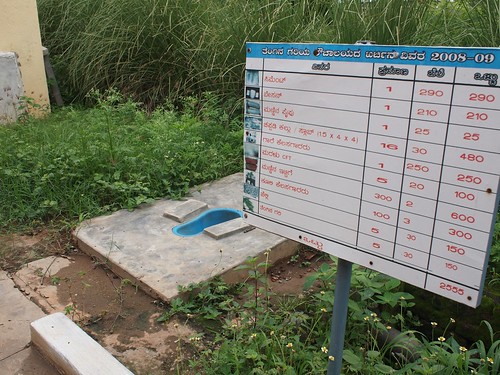Cathy is visiting India to visit organizational partners for the Lilly project. We are also exploring ways in which Global SE and the Lilly fellowship can become more synergistic. Here, Cathy describes her thoughts on a recent trip, mirroring in same ways what the four students and I did two weeks ago.
By Cathy McConnell, Director of the Lilly Program
I visited the Swami Vivekananda Youth Movement (SVYM) Hospital and outreach facilities in Saragur, Mysore District. SVYM was started 27 years ago by four newly-minted med school graduates, who, in the course of performing community service for skin disorders, found that their treatments had little effect on the patients. They soon discovered that unless they attended to other health and environmental issues as well, their treatments would continue to be ineffective. Thus began the genesis of their rural health center and community outreach programming.
My travel partner was Akhila Ramesh, the director of a start-up NGO called Nivasa, an organization dedicated to “redefining the rural landscape with cultural sensitivity.” An architect by training, Akhila’s interests lie in constructing cost-effective housing and outdoor toilets in rural areas. SVYM has been involved in rural toilet building for the past 10 years. It was through Akhila’s interests that I received a highly informative lesson in rural sanitation.
SVYM began a sanitation initiative ten years ago; at the time, only 7% of the rural population used toilets. They spent the first 5 years creating awareness using a number of approaches. They worked with the 32 district officials to receive permission to educate their communities about the benefits of toilet usage and the health hazards of non-usage. These hazards ranged from personal health issues such as the effects on women not relieving themselves during daylight hours, to environmental issues such as disease from fecal matter and water contamination. As community members became more convinced of the merits of toilet use, they started asking the officials to allow SVYM to install them. 
Another approach SVYM employed was initiating a school lunch program as an incentive for parents to send their children to school. Once the children were enrolled in school, a multi-pronged effort was used to deliver the pro-toilet message, including delivering education sessions using pictures that incorporated characters taken from the local culture, playing modified versions of board games such as chutes and ladders, bringing in street theater, and re-writing lyrics to songs the children love to sing over and over. As could be expected, once the children bought in, they started asking their parents for the goods.
There are several toilet designs available, all of which are built outside the family home. These are pit toilets, but some include an option for pumping water into the stall for personal cleaning and flushing. The design most favored by SVYM is what is known as the two-pit toilet. Below a single entry point are two tubes that take the waste to two different pits. While one pit is in use, the other is closed off. When the first one fills (in 5-7 months for a family of 5, we were told), it is sealed and the waste is left to compost. When the second one fills, the compost is removed from the first pit, and it is available again for use.
When SVYM began installing toilets five years ago, they had to raise the funds to do so entirely on their own. NGOs are not able to receive government support for the first three years of any initiative; instead, they must find outside funding and establish a track record before the government will allocate resources. Rotary was one source of support in the early stages. Now that they have proven themselves, they have been receiving government funds for the last two years. They receive 3000 rupees (≈$60) per toilet in government funding after each toilet has been constructed. This amount is not enough to cover the cost of constructing the second of the two pits, but SVYM has found that once the toilets are installed, the family becomes accostomed to using them, and in the approximately six months it takes to fill the first pit, they can usually come up with the money to construct the second. According to our host, toilet installation has reached 45% of all homes in the area, and once installed, use is 100%.
Our host had been with the project from inception and spoke passionately about how they had learned to employ effective educational strategies to achieve their mission. At the conclusion of his (at times all-too-graphic) power point presentation, he included this thought:
It is not because things are difficult that we do not dare,
It is because we do not dare that things are difficult.
Akhila took comfort and inspiration from these words. This presentation and our subsequent site visit to the SVYM housing project re-oriented her thoughts about her construction plans for the village she is working with. She is now looking to develop and incorporate an education component before beginning any construction.






I have been reading your posts for the last couple of hours, and it all has been very informative and well written. I did want to allow you understand that for some reason this post doesnt seem to work in Internet Explorer. On a side note, I had been wondering should you wanted to swap blogroll links? I hope to hear from you soon!